Sign Systems: Counting Down to the Pan Am Games
by all | 15 September 2014 1:30 pm
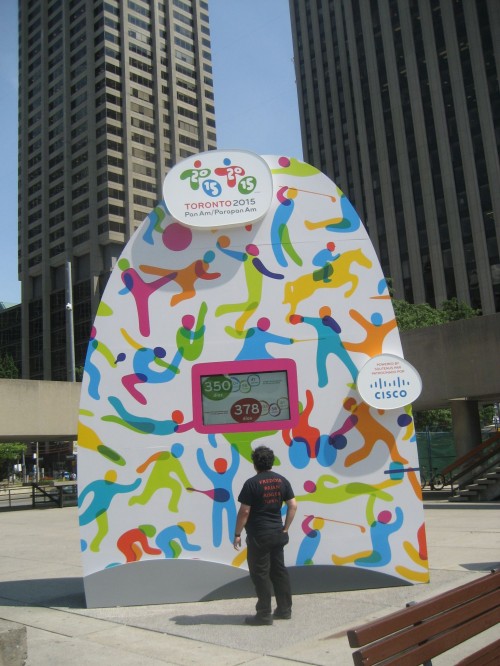 [1]
[1]Photo by Peter Saunders
By Peter Saunders
In the summer of 2015, Toronto and other cities in Southern Ontario will host the 17th Pan American (Pan Am) Games and the fifth Parapan Games. They will represent the largest international multi-sport event held in Canada to date, about twice as large as Vancouver’s 2010 Winter Olympic Games.
On July 11 and 12, 2014, ‘We Are Pan Am’ festivities took place in Nathan Phillips Square, in front of Toronto’s City Hall, to celebrate the one-year countdown to the games. Signage played a major role in the two-day festival, including an interactive mural, vehicle graphics and, most significantly for daily crowds in the public square, the installation of a giant countdown clock and a smaller touch-screen kiosk.
A puzzling mural
One of the ‘premier partners’ sponsoring the games is Chevrolet, which is heavily involved in organizing a 20,000-strong volunteer program. As such, the automaker’s Toronto-based creative agency, MacLaren McCann, sought to showcase the community-oriented program in a fun way at the countdown festival.
“We came up with the idea of a crowdsourced mural,” says Ann Solecki, one of the agency’s art directors. “It was born out of a desire to illustrate how volunteering is a large gesture comprised of the smaller efforts of a number of committed individuals all working toward the same goal.”
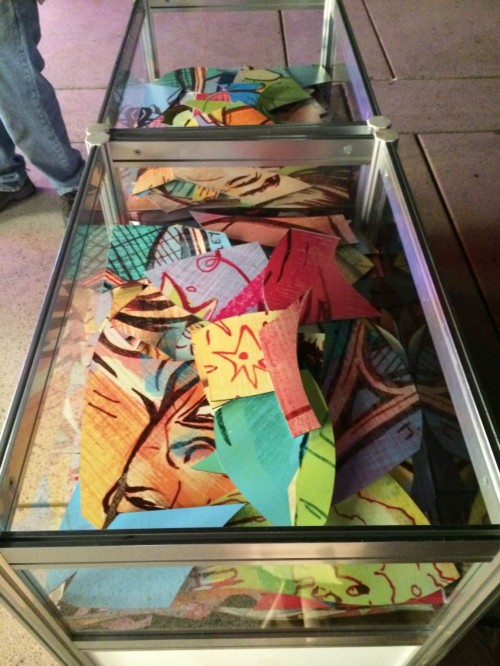 [2]
[2]The Exhibit Store printed and cut two versions of Chevrolet’s volunteer-themed artwork—one in black-and-white for the background and another in full colour for the ‘puzzle pieces.’ Photos courtesy MacLaren McCann
To design the 2.4 x 7.3-m (8 x 24-ft) mural, MacLaren McCann turned to Jacqui Oakley, a Hamilton-based freelance illustrator who teaches art at the Ontario College of Art & Design University (OCAD U) in Toronto.
“Jacqui came highly recommended,” says Solecki. “We were immediately struck with her beautiful, painterly style and sense of whimsy. We knew she would be able to compose a mural that conveyed the sense of community and spirit we were searching for.”
“We liked her style, spirit of fun and concept of play,” says Cathy Mowat, Chevrolet’s manager of digital and social marketing operations.
“They wanted a vibrant, colourful piece from a local artist,” says Oakley. “It was a lot of fun to work with and totally unique.”
She drew her original artwork—depicting a diverse range of volunteers and athletes in action—in black and white at one-third of the mural’s final scale, vectorized her linework in Adobe Illustrator software and applied colour with Adobe Photoshop. Then she divided the image into pieces, based on an approximate count provided by the agency.
“This way, I had a separate file based on the same drawing,” she says.
The Exhibit Store in Toronto handled the project from there in terms of printing and fabrication. The ‘divided’ file was printed at 100 dots-per-inch (dpi) onto 3-mm (0.12-in.) thick aluminum composite panel and cut with a computer numerical control (CNC) router. The linework was also printed onto additional sheets of the same substrate, but not cut. This way, the final mural would combine the sense of both a jigsaw puzzle and a colouring book.
“There are markings to denote the art like a ‘paint by numbers’ piece,” says Mowat.
The Exhibit Store attached the linework sheets with Velcro to an exhibition frame system from Octanorm Canada in Oakville, Ont. The CNC-routed pieces could then be placed on top of the linework with a double-sided adhesive tape backing.
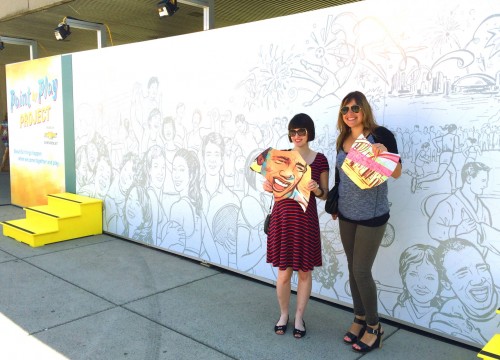 [3]
[3]Freelance illustrator Jacqui Oakley (left) and MacLaren McCann art director Ann Solecki (right) unveiled the mural at Nathan Phillips Square in July. Photos courtesy Jacqui Oakley
Finally, the mural was set up on July 10 and unveiled on July 11 as the ‘Paint By Play Project’ at Nathan Phillips Square for the countdown festival. After Oakley applied the first piece of the puzzle herself, children were invited to help complete it.
“I don’t often get to see people interacting with my artwork,” she says. “Seeing kids place the jigsaw puzzle together was so much fun. Anyone who placed a piece on the mural could sign their name in a book and receive a free magnetic puzzle of their own to take home. Later, a border will be added around the mural featuring all of those signatures and it will go on to different venues to advertise Chevrolet’s involvement in the Pan Am Games. It just won’t be a puzzle again, as the pieces are already stuck in place.”
“We absolutely want the signatures of those involved in the production of the mural to live on in its final home,” says Solecki. “How large and with what rigidity we design the border will depend on where the mural is housed come the time of the games.”
Wrapped in flags
Fittingly for an automaker, Chevrolet’s display area at the festival also showcased vehicle graphics, with a sedan and a sport utility vehicle (SUV) wrapped in the flags of the nations that will compete in the games, along with the Toronto Pan Am 2015 logo.
“We’ve had that wrap in place for a while now, as our sponsorship of the games began a few years ago,” says Mowat. “It’s been to auto shows and other ‘milestone’ Pan Am events.”
Chevrolet will roll out more such wraps in the months to come, as it unveils a fleet of more than 1,000 vehicles for the games.
“Some of the vehicles will be fully wrapped,” says Mowat. “All of them will at least feature logos and decals.”
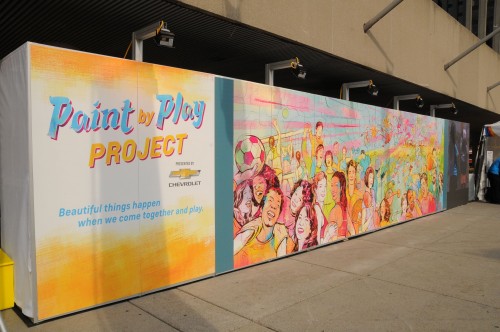 [4]
[4]Following the completion of the puzzle, the mural will be showcased at different venues relating to the Pan Am Games. Photos courtesy Chevrolet Canada
A clock like no other
Meanwhile, the countdown clock and kiosk were ‘woken from slumber’ at the festival by a team of acrobats on stilts from Montreal-based Cirque du Soleil (another premier partner of the games), Brazilian drummers and breakdancers performing a charivari discordant serenade and BMX cyclists doing tricks around the two structures.
The 5.5-m (18-ft) tall, 4.1-m (13.5-ft) wide and 1.2-m (4-ft) thick countdown clock is decorated with the games’ colourful sports pictograms and showcases five 1.2-m (47-in.) DynaScan industrial-grade liquid crystal displays (LCDs)—four on the front, one on the back—counting down the days, minutes and seconds to the start of the games and playing a series of videos every five minutes. Each of the screens boasts 2,500 candelas per square metre (cd/m2) of luminance to ensure content is legible in daylight.
Weighing 7.3 t (8 tons) and connected to 5 km (3.1 mi) of dedicated fibre optic cabling infrastructure running underground to a downtown Cisco data centre—reportedly capable of sending one gigabit of data per second, equivalent to the Internet connectivity requirements of a community of 25,000 homes—the clock will remain on-site until the Parapan Games end on August 15, 2015.
“It’s the first of its kind in the world and it will be an important landmark for locals and visitors alike, announcing the games are quickly approaching,” says Nitin Kawale, president of Cisco Canada, which developed the clock as a premier partner and official information and communications technology (ICT) provider for the games. “This is more than just a clock; it’s a social portal enabled by the ‘Internet of Everything.’”
“For athletes, the clock is a reminder of how close the games are,” says Ryan Homsy, a handball goalie who has competed at the Pan Am Games twice before and serves as an ‘ambassador’ for Cisco. “As a member of the Canadian handball team, I’m proud to have been there to unveil the clock and look forward to helping win a medal on home soil.”
The clock was fully funded and constructed by Cisco and its partners. Housed in a metal frame with an aluminum exterior cladding, it and the kiosk took a combined 7,000 hours from 40 people to build, including 28 Cisco engineers.
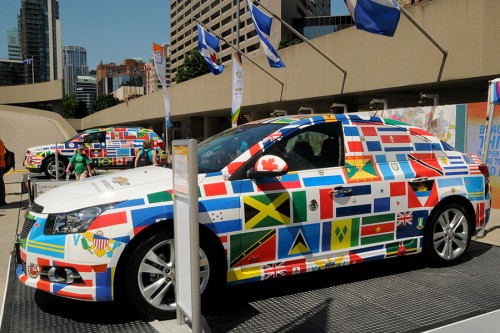 [5]
[5]The mural was flanked by some of Chevrolet’s graphic-wrapped vehicles, featuring the flags of nations that will compete in the games.
“The planning began about six months ago,” says Jeff Seifert, Cisco’s chief technology officer (CTO). “We also had students from George Brown College in Toronto and University of Ontario Institute of Technology (UOIT) in Oshawa, Ont., help assemble the clock.”
The clock contains six Cisco 3010 industrial Ethernet switches—including five video and one audio—to connect to the LCD panels. Further, Cisco’s iServices software platform operates the clock, supported by the company’s unified computing system (UCS) and protected by ASA-55/85X firewalls and Sourcefire intrusion software.
Besides those components, however, the large structure called for specialized skills beyond Cisco’s in-house capabilities. Toronto-based Fourth Wall Media, a digital out-of-home (DOOH) and kiosk agency that serves as Pattison Outdoor Advertising’s ‘experiential’ marketing division, oversaw the development of the physical structure, based on mockups created in-house using a three-dimensional (3-D) printer, and facilitated the flow of content from Toronto 2015 (TO2015) Organizing Committee.
“We’ve been involved in big projects before, like an 8.5-m (28-ft) tall replica lighthouse in downtown Toronto last year for Nova Scotia Tourism,” says Dmitri Melamed, vice-president (VP) of production. “In this case, we brought all of the necessary partners together on the same page, procured some of the equipment and facilitated bench-testing for fabrication, which began about one month before the clock’s debut at the countdown festival.”
These partners included Enseicom, a sign, billboard and street furniture manufacturer based in Lachine, Que., which fabricated weatherproof cabinets to protect Cisco’s technology inside the clock and kiosk; Optimum Graphiques, a large-format print house in Laval, Que., which produced the vinyl pictograms for the exterior surface; and X2O Media, a Montreal-based digital signage software developer.
“We are a longtime partner of Cisco and have worked with their digital signage media players before, so it was quite natural that they reached out to us,” says Vern Freedlander, X2O’s VP of production. “Our contribution for this project was more of a process than a product. We built the user experience, so our challenge was to design a compelling interface that would allow visitors to navigate intuitively through content, including wayfinding, news, information and video clips. Our graphic designers also had to maintain the TO2015 branding.”
The clock and kiosk were delivered to Toronto on a 16-m (53-ft) flatbed transport truck and placed into position with a 15-t (16.5-ton) Broderson deck crane. Fourth Wall co-ordinated the project with on-site engineering firm Blackwell and commercial sign installation, maintenance and repair contracting firm Trade Sync, based in Brantford, Ont.
“They’ve installed at lot of the digital signage at Toronto’s Yonge-Dundas Square,” says Melamed.
Since the clock is about the same height as the average male giraffe, it is hard to miss. During the games, it will broadcast sports footage to crowds in the square. It also helps draw attention to the more human-scale kiosk that serves as a window to the aforementioned social portal.
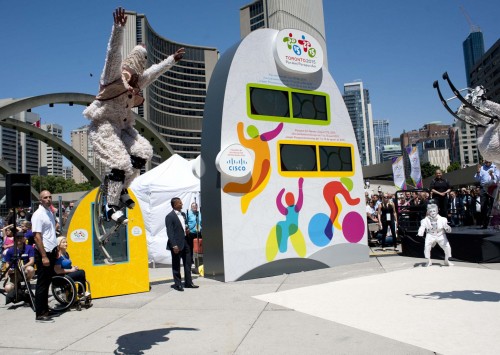 [6]
[6]On the same day as the mural project, Cisco unveiled its countdown clock and kiosk with the assistance of Cirque du Soleil acrobats. Photo courtesy Cisco
Games at your fingertips
At the 2-m (6.5-ft) tall, 1.5-m (5-ft) wide and 0.5-m (1.5-ft) thick kiosk, which houses two Cisco 3010 industrial Ethernet switches in a similar metal frame with aluminum exterior cladding, visitors can access information about the games, the clock and Cisco’s technology at either of two 1.2-m screens. Interactivity is enabled by touch-screen foil, reinforced behind a layer of security glass.
Visitors can also use a custom app to take a photo of themselves in the public square, download it to their smartphone and create a virtual postcard for sharing via social networks and/or viewing on the clock’s own online photo page.
“We will turn on new features over the next year,” says Seifert. “We will unveil near-field communications (NFC) capabilities, for example, and embedded camera technology that can enable two-way video, so we can connect athletes with their hometowns. There will constantly be new content and surprises.”
The project will also reach beyond Nathan Phillips Square. While the kiosk is a long-term installation like the clock, anchored in cement, Cisco says it will also serve as a model for additional, shorter-term ‘satellite’ kiosk clocks that will appear at other location as the games draw nearer, using the same network infrastructure.
“The secondary clocks will be derivative of the main one, but with some variations depending on their location,” says Freedlander.
“We also have widgets that can go on other people’s digital signage networks,” says Seifert. “Cisco is a business-to-business (B2B) company, not business-to-consumer (B2C), and this project is a way to show our customers—including retailers, banks and technology partners—what they can do with our products.”
With files from the TO2015 Organizing Committee, Chevrolet Canada, MacLaren McCann, Jacqui Oakley, the Exhibit Store, Octanorm Canada, Cisco Canada, Fourth Wall Media, Enseicom, Optimum Graphiques, X2O Media and Trade Sync. For more information, visit www.toronto2015.org[7], www.chevrolet.gm.ca[8], www.maclaren.com[9], www.jacquioakley.com[10], www.exhibitstore.ca[11], www.octanorm.net[12], www.ciscotoronto2015.ca[13], www.fourthwall.ca[14], www.ensei.com[15], www.optimumgraphiques.com[16], www.x2omedia.com[17] and www.tradesync.ca[18].
- [Image]: http://www.signmedia.ca/wp-content/uploads/2014/09/IMG_8055.jpg
- [Image]: http://www.signmedia.ca/wp-content/uploads/2014/09/IMG_2802.jpg
- [Image]: http://www.signmedia.ca/wp-content/uploads/2014/09/PANAM_oakley_pics_bg.jpg
- [Image]: http://www.signmedia.ca/wp-content/uploads/2014/09/14617313256_a0461cb277_o.jpg
- [Image]: http://www.signmedia.ca/wp-content/uploads/2014/09/14443559720_e1b61d8fd8_o.jpg
- [Image]: http://www.signmedia.ca/wp-content/uploads/2014/09/ciscoclock.jpg
- www.toronto2015.org: http://www.toronto2015.org
- www.chevrolet.gm.ca: http://www.chevrolet.gm.ca
- www.maclaren.com: http://www.maclaren.com
- www.jacquioakley.com: http://www.jacquioakley.com
- www.exhibitstore.ca: http://www.exhibitstore.ca
- www.octanorm.net: http://www.octanorm.net
- www.ciscotoronto2015.ca: http://www.ciscotoronto2015.ca
- www.fourthwall.ca: http://www.fourthwall.ca
- www.ensei.com: http://www.ensei.com
- www.optimumgraphiques.com: http://www.optimumgraphiques.com
- www.x2omedia.com: http://www.x2omedia.com
- www.tradesync.ca: http://www.tradesync.ca
Source URL: https://www.signmedia.ca/sign-systems-counting-down-to-the-pan-am-games/

